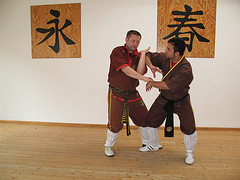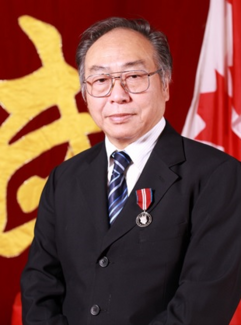
Jeet Kune Do, or "The way of the intercepting fist" in Cantonese, abbreviated JKD, is a hybrid philosophy of martial arts heavily influenced by the personal philosophy and experiences of martial artist Bruce Lee. Lee, who founded the system on July 9, 1967, referred to it as "non-classical", suggesting that it is a formless form of Chinese Kung Fu. Unlike more traditional martial arts, Jeet Kune Do is not fixed or patterned and is a philosophy with guiding ideas. Named for the Wing Chun concept of interception or attacking when one's opponent is about to attack, Jeet Kune Do's practitioners believe in minimal effort with maximum effect.
This page explains commonly used terms in chess in alphabetical order. Some of these have their own pages, like fork and pin. For a list of unorthodox chess pieces, see Fairy chess piece; for a list of terms specific to chess problems, see Glossary of chess problems; for a list of chess-related games, see List of chess variants.
Chum Kiu is the second of three open-hand forms of Wing Chun Kung Fu. It builds upon many of the basic principles and techniques learned in the first Wing Chun open-hand form, Siu Nim Tao. The form may also be called Chum Kil.

Japanese martial arts refer to the variety of martial arts native to the country of Japan. At least three Japanese terms are used interchangeably with the English phrase Japanese martial arts.

A strike is a directed physical attack with either a part of the human body or with an inanimate object intended to cause blunt trauma or penetrating trauma upon an opponent.

The butterfly sword is a short dao, or single-edged sword, originally from southern China, though it has also seen use in the north.

Deer horn knives, also known as crescent moon knives or duck blades, are specialised Chinese bladed weapons consisting of two steel crescents crossing. They are used in Chinese martial arts. This crossing produces four curved, clawlike points, one of which is extended as the "main" blade. The practitioner grips the wrapped middle of the lengthened crescent with the other acting as a hand guard. They are relatively short weapons that are easily concealable in traditional Chinese clothing, and are usually trained in pairs, one for each hand.

Fencing – family of combat sports using bladed weapons. Fencing is one of four sports which have been featured at every one of the modern Olympic Games. Also known as modern fencing to distinguish it from historical fencing.
The different branches of the Chinese martial art of Wing Chun can be thought of as describing both the differing traditions and interpretations of Wing Chun, and the teacher-student relationships which perpetuate them.

An armlock in grappling is a single or double joint lock that hyperextends, hyperflexes or hyperrotates the elbow joint or shoulder joint. An armlock that hyperflexes or hyperrotates the shoulder joint is referred to as a shoulder lock, and an armlock that hyperextends the elbow joint is called an armbar. Depending on the joint flexibility of a person, armlocks that hyperrotate the shoulder joint can also hyperrotate the elbow joint, and vice versa.

Back mount, or rear mount, is a dominant grappling position where the practitioner is behind his opponent in such a way that he has control of his opponent. Ideally, the opponent will be recumbent (prone), while the practitioner centers his weight atop the opponent, either in a seated or recumbent posture. Many consider back mount to be a very dominant, perhaps even the most advantageous position in grappling. This is due to the practitioner being able to attack with strikes and submissions with the opponent having a severely limited ability to see incoming attacks and defend against them.

In martial arts, stances are the distribution, foot orientation and body positions adopted when attacking, defending, advancing or retreating. In many Asian martial arts, the most widely used stance is a shallow standing squat. This position is generally employed as it is a neutral and agile position from which both attacks and defences may be launched. It provides for the delivery of force when attacking and stability when defending.
The touch of death refers to any martial arts technique reputed to kill using seemingly less than lethal force targeted at specific areas of the body.

Tactics are very important to playing well in modern fencing and although technique is important in the sport, using an array of tactics will help fencers make the most of that technique.

In association football, a cross is a medium- to-long-range pass from a wide area of the field towards the centre of the field near the opponent's goal. Specifically, the intention of a cross is to directly bring the ball into the box from an angle that allows the attacking forwards to more easily aim for goal with their head or feet. Crosses are generally airborne (floated) to clear nearby defenders, but can also be hit with force along the ground (drilled). It is a quick and effective move.

Weng Chun Kung Fu also known as Chi Sim Weng Chun is a Chinese Martial Art. Weng Chun in its present form is being preserved by Grand Master Andreas Hoffmann who is the successor of the art following late Grand Master Wai Yan.

Wan Kam Leung is a Chinese martial artist and qigong practitioner who developed and currently teaches Practical Wing Chun in Kowloon, Hong Kong. Wan studied Wing Chun kung fu under Wong Shun Leung

James Cama Sr. was an American martial arts practitioner and teacher.

Sunny Tang is a practitioner of Wing Chun Kung Fu and Wushu. He was the 2004 World Traditional Masters champion and is the founder of Wushu Canada, as well as the Sunny Tang Martial Arts Centre chain of martial arts centres in Canada. He is a recipient of the Queen Elizabeth II Diamond Jubilee Medal and an inductee into the Canadian Martial Arts Hall of Fame.

















